Museum
The former abbey is now the location of an art museum, the Musée Jacquemart-André. [2] Like the museum of the same name in Paris it houses a part of the former collection of artworks of Nélie Jacquemart-André. At her death in 1912 she gave it to the Institut de France and asked that a museum should be created in Chaalis, where she had spent her childhood.

The Musée Jacquemart-André is a private museum located at 158 Boulevard Haussmann in the 8th arrondissement of Paris. The museum was created from the private home of Édouard André (1833–1894) and Nélie Jacquemart (1841–1912) to display the art they collected during their lives.

Paris is the capital and most populous city of France, with an area of 105 square kilometres and an official estimated population of 2,140,526 residents as of 1 January 2019. Since the 17th century, Paris has been one of Europe's major centres of finance, diplomacy, commerce, fashion, science, and the arts. The City of Paris is the centre and seat of government of the Île-de-France, or Paris Region, which has an estimated official 2019 population of 12,213,364, or about 18 percent of the population of France. The Paris Region had a GDP of €709 billion in 2017. According to the Economist Intelligence Unit Worldwide Cost of Living Survey in 2018, Paris was the second most expensive city in the world, after Singapore, and ahead of Zürich, Hong Kong, Oslo and Geneva. Another source ranked Paris as most expensive, on a par with Singapore and Hong Kong, in 2018.
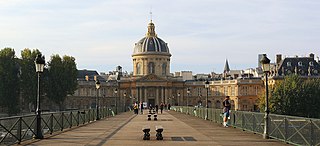
The Institut de France is a French learned society, grouping five académies, including the Académie française.
The museum continues to display this very rich collection which features paintings by Giotto, Cima da Conegliano, Luca Signorelli, Francesco Francia, Lorenzo di Credi, Joos van Cleve, Tintoretto, Palma the Younger, Jan Davidsz de Heem, Philippe de Champaigne, Charles Le Brun, Nicolas de Largillière, François Desportes, François Boucher, Rosalba Carriera, Giovanni Paolo Pannini and Jean-Baptiste Greuze; sculptures by Baccio Bandinelli, François Girardon, Jean-Antoine Houdon, Augustin Pajou, Jean-Baptiste Lemoyne and Edme-François-Étienne Gois; furniture and decorative art; and a collection of Indian items.
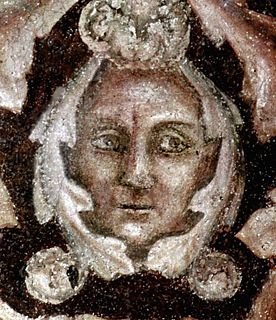
Giotto di Bondone, known mononymously as Giotto and Latinised as Giottus, was an Italian painter and architect from Florence during the Late Middle Ages. He worked during the Gothic/Proto-Renaissance period.

Giovanni Battista Cima, also called Cima da Conegliano, was an Italian Renaissance painter, who mostly worked in Venice. He can be considered part of the Venetian school, though he was also influenced by Antonello da Messina, in the emphasis he gives to landscape backgrounds and the tranquil atmosphere of his works. Once formed his style did not change greatly. He mostly painted religious subjects, often on a small scale for homes rather than churches, but also a few, mostly small, mythological ones.

Luca Signorelli was an Italian Renaissance painter who was noted in particular for his ability as a draftsman and his use of foreshortening. His massive frescoes of the Last Judgment (1499–1503) in Orvieto Cathedral are considered his masterpiece.

Rococo, less commonly roccoco, or "Late Baroque", is an exceptionally ornamental and theatrical style of architecture, art and decoration which combines asymmetry, scrolling curves, gilding, white and pastel colors, sculpted molding, and trompe l'oeil frescoes to create the illusions of surprise, motion and drama. It first appeared in France and Italy in the 1730s and spread to Central Europe in the 1750s and 1760s. It is often described as the final expression of the Baroque movement.
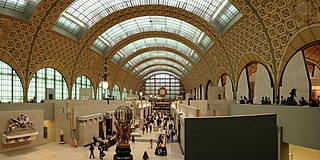
The Musée d'Orsay is a museum in Paris, France, on the Left Bank of the Seine. It is housed in the former Gare d'Orsay, a Beaux-Arts railway station built between 1898 and 1900. The museum holds mainly French art dating from 1848 to 1914, including paintings, sculptures, furniture, and photography. It houses the largest collection of impressionist and post-Impressionist masterpieces in the world, by painters including Monet, Manet, Degas, Renoir, Cézanne, Seurat, Sisley, Gauguin, and Van Gogh. Many of these works were held at the Galerie nationale du Jeu de Paume prior to the museum's opening in 1986. It is one of the largest art museums in Europe. Musée d'Orsay had 3.177 million visitors in 2017.
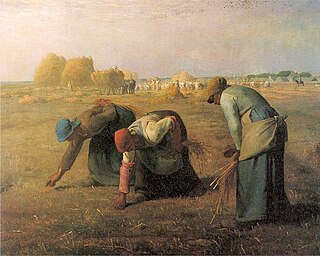
The Barbizon school of painters were part of an art movement towards Realism in art, which arose in the context of the dominant Romantic Movement of the time. The Barbizon school was active roughly from 1830 through 1870. It takes its name from the village of Barbizon, France, near the Forest of Fontainebleau, where many of the artists gathered. Some of the most prominent features of this school are its tonal qualities, color, loose brushwork, and softness of form.

Augustin Pajou was a French sculptor, born in Paris. At eighteen he won the Prix de Rome, and at thirty exhibited his Pluton tenant Cerbère enchaîné.

Jean-Honoré Fragonard was a French painter and printmaker whose late Rococo manner was distinguished by remarkable facility, exuberance, and hedonism. One of the most prolific artists active in the last decades of the Ancien Régime, Fragonard produced more than 550 paintings, of which only five are dated. Among his most popular works are genre paintings conveying an atmosphere of intimacy and veiled eroticism.

The Château de Chantilly is a historic château located in the town of Chantilly, France, about 50 kilometers north of Paris.
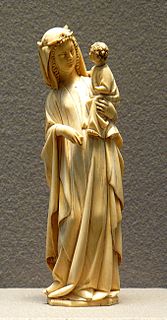
French art consists of the visual and plastic arts originating from the geographical area of France. Modern France was the main centre for the European art of the Upper Paleolithic, then left many megalithic monuments, and in the Iron Age many of the most impressive finds of early Celtic art. The Gallo-Roman period left a distinctive provincial style of sculpture, and the region around the modern Franco-German border led the empire in the mass production of finely decorated Ancient Roman pottery, which was exported to Italy and elsewhere on a large scale. With Merovingian art the story of French styles as a distinct and influential element in the wider development of the art of Christian Europe begins.

Walter Gay was an American painter noted both for his genre paintings of French peasants, paintings of opulent interior scenes and was a notable art collector.

Charlotte de Rothschild was a French socialite, painter, and a member of the prominent Rothschild banking family of France.
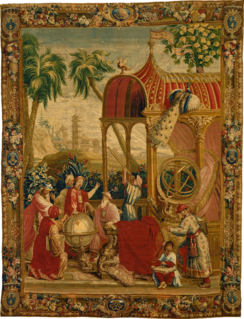
The Beauvais Manufactory is a historic tapestry factory in Beauvais, France. It was the second in importance, after the Gobelins Manufactory, of French tapestry workshops that were established under the general direction of Jean-Baptiste Colbert, the finance minister of Louis XIV. Whereas the royal Gobelins Manufactory executed tapestries for the royal residences and as ambassadorial gifts, the manufacture at Beauvais remained a private enterprise. Beauvais specialised in low-warp tapestry weaving, although the letters patent of 1664, authorising the company and offering royal protection, left the field open for the production of high-warp tapestry as well.

Rue du Bac is a street in Paris situated in the 7th arrondissement. The street, which is 1150 m long, begins at the junction of the quais Voltaire and Anatole-France and ends at the rue de Sèvres. The street used to be in the fashionable Faubourg Saint-Germain.

Jacquemart de Hesdin was a French miniature painter working in the International Gothic style. In English, he is also called Jacquemart of Hesdin. During his lifetime, his name was spelt in a number of ways, including as Jacquemart de Odin.
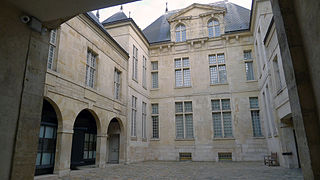
The Musée Cognacq-Jay is a museum located in the Hôtel Donon in the 3rd arrondissement at 8 rue Elzévir, Paris, France. It is open daily except Monday; admission is free. The nearest Metro stations are Saint-Paul and Chemin Vert.

Henriette Anne Louise d'Aguesseau, Duchess of Noailles, Princess of Tingry, was a French salon hostess and duchess, the heiress of her grandfather, Henri François d'Aguesseau, and wife of Jean Louis François de Noailles, Count and Duke of Ayen.
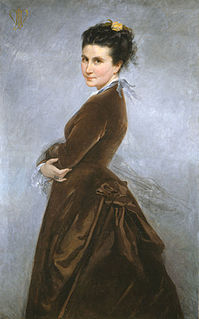
Cornélie Barbe Hyacinthe Jacquemart, known as Nélie was a French painter, art collector and patroness of the arts.

The Musée des beaux-arts d'Angers is a museum of art located in a mansion, the "logis Barrault", place Saint-Éloi near the historic city of Angers.

Édouard François André (1833–1894) was a French banker, politician, soldier and art collector. He was the husband of Nélie Jacquemart-André, the society painter. Their art collection is preserved at the Musée Jacquemart-André in Paris.

Helena Fourment or Hélène Fourment was the second wife of Baroque painter Peter Paul Rubens. She was the subject of a few portraits by Rubens, and also modeled for other religious and mythological paintings.

The Pseudo-Jacquemart was an anonymous master illuminator active in Paris and Bourges between 1380 and 1415. He owed his name to his close collaboration with painter Jacquemart de Hesdin.































